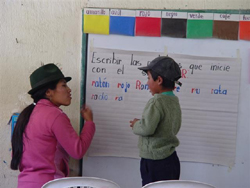You are here » Home » Telling Our Story
First Person
Children in the remote Andes learn Spanish for the first time
Learning Through Poems and Rhymes

| |
Photo: UASB/Ana Alvarado
|
|
Florida Ante, a USAID-trained teacher, shows a student how to write at her school near La Vaquería, Ecuador.
With a teaching toolkit that includes, poems, rhymes, stories, games, and songs in Spanish, USAID-trained teachers help children improve their vocabulary, fluency, and reading and comprehension skills in a language that is foreign to them.
|
At an altitude of 12,000 feet in the middle of the Ecuadorian Andes and well off the beaten path you find La Vaquería, a small indigenous village. The trip is well worth it — and not just for the stunning scenery of the Andes Mountain and the famed Cotopaxi volcano along the way, but also for the chance to discover the treasures this community holds. Among those treasures is the Dolores Cacuango primary school.
Several years ago, the only language a visitor to this community would have heard is Quichua. But the language taught at the sole primary school among 15 neighboring communities is Spanish. Because they did not speak the same language as the instructors, students often struggled and many dropped out, never obtaining an elementary education.
Today, that situation is slowly changing. A USAID program has been training teachers in creative ways to make learning in Spanish easier for non-native speakers. As they learn to read and write in Spanish, they also learn the skills to write in Quichua.
Florinda Ante, a young teacher trained by the program, calms down 22 excited first and second grade students as she starts the day’s lesson. With a teaching toolkit that includes, poems, rhymes, stories, games, and songs in Spanish, she can more effectively help children improve their vocabulary, fluency, and reading and comprehension skills.
Florinda is one of three participant teachers at the school who attended the USAID-sponsored training, where they learned proven teaching methodologies and discussed lessons learned with participating school teachers. Committed to improving the children’s Spanish proficiency, Florinda also contributes by sharing her experiences and involving parents in the educational process.
When the bell rings and the school day is over at Dolores Cacuango primary school, children run home to play, help with chores, and share the new words they learned that day with their families. As they learn Spanish, their chances of finishing school — and their future opportunities — improve.
Print-friendly version of this page (454kb - PDF)
Click here for high-res photo
Back to Top ^ | 

